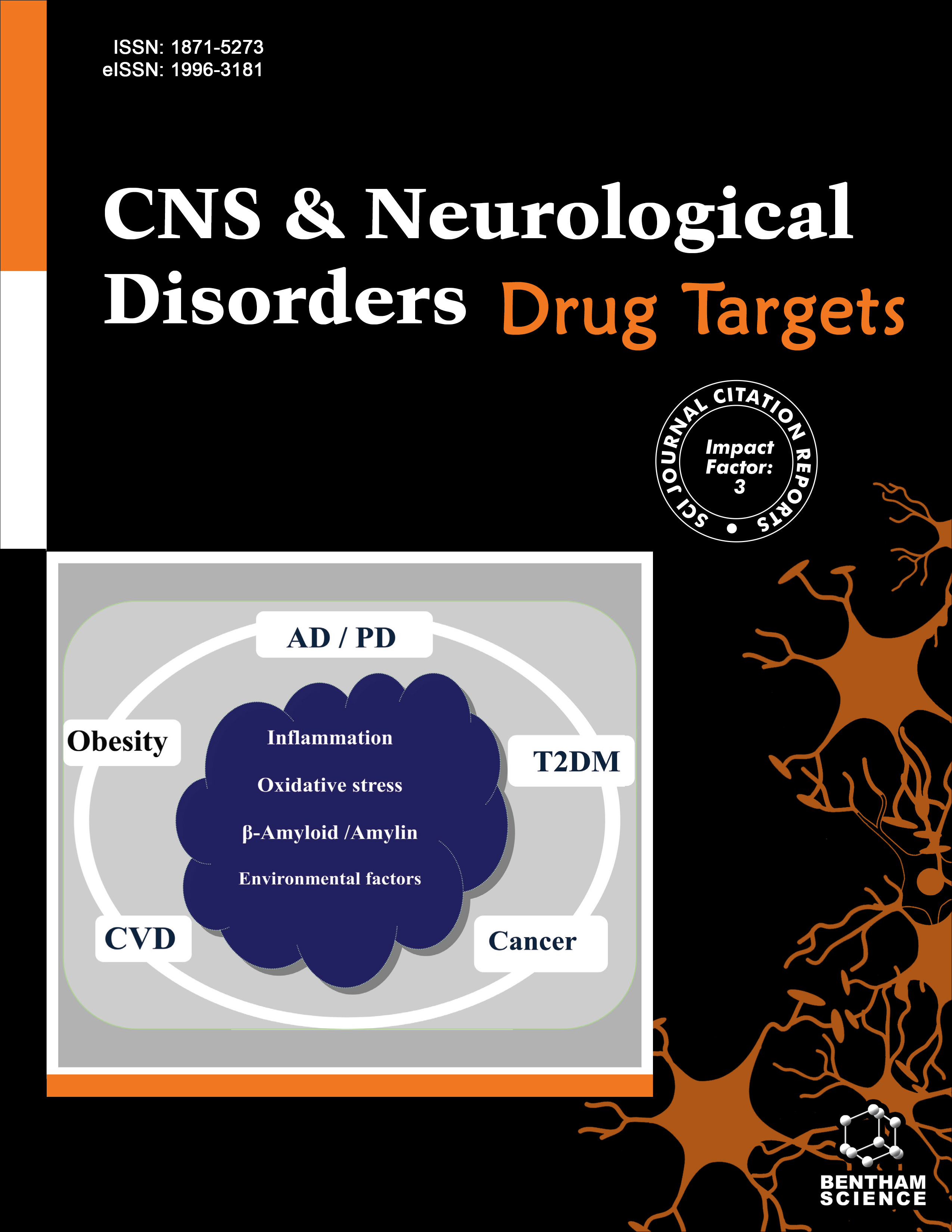- Home
- A-Z Publications
- CNS & Neurological Disorders - Drug Targets (Formerly Current Drug Targets - CNS & Neurological Disorders)
- Previous Issues
- Volume 17, Issue 3, 2018
CNS & Neurological Disorders - Drug Targets (Formerly Current Drug Targets - CNS & Neurological Disorders) - Volume 17, Issue 3, 2018
Volume 17, Issue 3, 2018
-
-
Current and Promising Therapies in Autosomal Recessive Ataxias
More LessAuthors: Vincent Picher-Martel and Nicolas DupreBackground & Objective: Ataxia is clinically characterized by unsteady gait and imbalance. Cerebellar disorders may arise from many causes such as metabolic diseases, stroke or genetic mutations. The genetic causes are classified by mode of inheritance and include autosomal dominant, X-linked and autosomal recessive ataxias. Many years have passed since the description of the Friedreich's ataxia, the most common auto Read More
-
-
-
Neurotransplantation Therapy and Cerebellar Reserve
More LessAuthors: Jan Cendelin, Hiroshi Mitoma and Mario MantoBackground & Objective: Neurotransplantation has been recently the focus of interest as a promising therapy to substitute lost cerebellar neurons and improve cerebellar ataxias. However, since cell differentiation and synaptic formation are required to obtain a functional circuitry, highly integrated reproduction of cerebellar anatomy is not a simple process. Rather than a genuine replacement, recent studies have shown t Read More
-
-
-
Physiological and Morphological Principles Underpinning Recruitment of the Cerebellar Reserve
More LessAuthors: Shinji Kakei, Takahiro Ishikawa, Jongho Lee, Takeru Honda and Donna S. HoffmanBackground: In order to optimize outcomes of novel therapies for cerebellar ataxias (CAs), it is desirable to start these therapies while declined functions are restorable: i.e. while the so-called cerebellar reserve remains. Objective: In this mini-review, we tried to define and discuss the cerebellar reserve from physiological and morphological points of view. Method: The cerebellar neuron circuitry is designed to generate Read More
-
-
-
Non-invasive Cerebellar Stimulation in Cerebellar Disorders
More LessBackground & Objective: Non-invasive brain stimulation (NIBS) might be a valuable therapeutic approach for neurological diseases by modifying the cortical activity in the human brain and promoting neural plasticity. Currently, researchers are exploring the use of NIBS on the cerebellum to promote functional neural changes in cerebellar disorders. In the presence of cerebellar dysfunction, several movement disorders, such Read More
-
-
-
Cognitive Impact of Cerebellar Damage: Is There a Future for Cognitive Rehabilitation?
More LessAuthors: Kim van Dun, Frank V. Overwalle, Mario Manto and Peter MarienBackground & Objective: During the past 3 decades, numerous neurophysiological, neuroimaging, experimental and clinical studies have evidenced a crucial role for the cerebellum in cognitive, affective and behavioral functions. As a result of the acknowledged modulatory role of the cerebellum upon remote structures such as the cerebral cortex, cerebellar injury may give rise to a constellation of behavioral, affective and cogniti Read More
-
-
-
The Underlying Role of Oxidative Stress in Neurodegeneration: A Mechanistic Review
More LessAuthors: Habib Yaribeygi, Yunes Panahi, Behjat Javadi and Amirhossein SahebkarBackground: Neurodegeneration is a condition in which progressive loss of function and structure of neurons occurs. Several lines of evidence suggest that oxidative stress has a central role in neurodegenerative diseases. Objective: The aim was to survey molecular mechanisms underlying the involvement of oxidative stress in developing different neurodegenerative diseases. Methods: Original and review articles were retri Read More
-
-
-
N-3 (Omega-3) Fatty Acids: Effects on Brain Dopamine Systems and Potential Role in the Etiology and Treatment of Neuropsychiatric Disorders
More LessAuthors: Michelle Healy-Stoffel and Beth LevantBackground & Objective: A number of neuropsychiatric disorders, including Parkinson's disease, schizophrenia, attention deficit hyperactivity disorder, and, to some extent, depression, involve dysregulation of the brain dopamine systems. The etiology of these diseases is multifactorial, involving genetic and environmental factors. Evidence suggests that inadequate levels of n-3 (omega- 3) polyunsaturated fatty acids (PU Read More
-
-
-
Clinical Observation of Electroencephalographic Changes and Risk of Convulsion Occurrence in Children Receiving Neural Precursor Cell Transplantation
More LessAuthors: Suqing Qu, Weipeng Liu, Hui Yang, Zhaoyan Wang, Yinxiang Yang, Fang Liu, Aruna Sharma, Hari Sharma and Zuo LuanPurpose: This study was intended to observe electroencephalographic (EEG) changes and convulsion attacks in children receiving neural precursor cell transplantation, and to explore the possibility of electrophysiological changes and risk of convulsion occurrence after cell transplantation. Method: 228 children were included in this study who received neural precursor cell transplantation in our hospital between March 2008 Read More
-
Volumes & issues
-
Volume 24 (2025)
-
Volume 23 (2024)
-
Volume 22 (2023)
-
Volume 21 (2022)
-
Volume 20 (2021)
-
Volume 19 (2020)
-
Volume 18 (2019)
-
Volume 17 (2018)
-
Volume 16 (2017)
-
Volume 15 (2016)
-
Volume 14 (2015)
-
Volume 13 (2014)
-
Volume 12 (2013)
-
Volume 11 (2012)
-
Volume 10 (2011)
-
Volume 9 (2010)
-
Volume 8 (2009)
-
Volume 7 (2008)
-
Volume 6 (2007)
-
Volume 5 (2006)
Most Read This Month
Article
content/journals/cnsnddt
Journal
10
5
false
en

Most Cited Most Cited RSS feed
-
-
A Retrospective, Multi-Center Cohort Study Evaluating the Severity- Related Effects of Cerebrolysin Treatment on Clinical Outcomes in Traumatic Brain Injury
Authors: Dafin F. Muresanu, Alexandru V. Ciurea, Radu M. Gorgan, Eva Gheorghita, Stefan I. Florian, Horatiu Stan, Alin Blaga, Nicolai Ianovici, Stefan M. Iencean, Dana Turliuc, Horia B. Davidescu, Cornel Mihalache, Felix M. Brehar, Anca . S. Mihaescu, Dinu C. Mardare, Aurelian Anghelescu, Carmen Chiparus, Magdalena Lapadat, Viorel Pruna, Dumitru Mohan, Constantin Costea, Daniel Costea, Claudiu Palade, Narcisa Bucur, Jesus Figueroa and Anton Alvarez
-
-
-
- More Less

